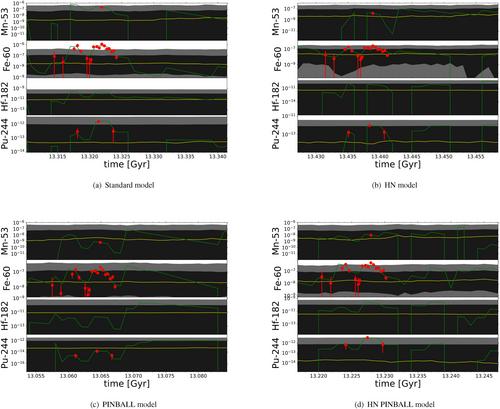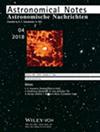利用短寿命放射性同位素可以得出超新星激波传播的结论吗?
IF 1
4区 物理与天体物理
Q3 ASTRONOMY & ASTROPHYSICS
引用次数: 0
摘要
我们运行了一个三维银河化学演化(GCE)模型来跟踪53Mn(仅来自Ia型超新星SNIa)、60Fe(仅来自核心坍缩超新星CCSNe)、182Hf(仅来自中质量恒星IMSs)和244Pu(仅来自中子星合并nsm)的传播。通过将三维GCE模型的预测与最近在深海底探测到的53Mn, 60Fe和244Pu进行比较,我们得出了它们在星际介质中的传播结论。本文章由计算机程序翻译,如有差异,请以英文原文为准。

Can We Draw Conclusions on Supernova Shock Wave Propagation Using Short-Lived Radioactive Isotopes?
We run a three-dimensional Galactic chemical evolution (GCE) model to follow the propagation of 53Mn (exclusively produced from type Ia supernovae, SNIa), 60Fe (exclusively produced from core-collapse supernovae, CCSNe), 182Hf (exclusively produced from intermediate mass stars, IMSs), and 244Pu (exclusively produced from neutron star mergers, NSMs). By comparing the predictions from our three-dimensional GCE model to recent detections of 53Mn, 60Fe, and 244Pu on the deep-sea floor, we draw conclusions about their propagation in the interstellar medium.
求助全文
通过发布文献求助,成功后即可免费获取论文全文。
去求助
来源期刊

Astronomische Nachrichten
地学天文-天文与天体物理
CiteScore
1.80
自引率
11.10%
发文量
57
审稿时长
4-8 weeks
期刊介绍:
Astronomische Nachrichten, founded in 1821 by H. C. Schumacher, is the oldest astronomical journal worldwide still being published. Famous astronomical discoveries and important papers on astronomy and astrophysics published in more than 300 volumes of the journal give an outstanding representation of the progress of astronomical research over the last 180 years. Today, Astronomical Notes/ Astronomische Nachrichten publishes articles in the field of observational and theoretical astrophysics and related topics in solar-system and solar physics. Additional, papers on astronomical instrumentation ground-based and space-based as well as papers about numerical astrophysical techniques and supercomputer modelling are covered. Papers can be completed by short video sequences in the electronic version. Astronomical Notes/ Astronomische Nachrichten also publishes special issues of meeting proceedings.
 求助内容:
求助内容: 应助结果提醒方式:
应助结果提醒方式:


